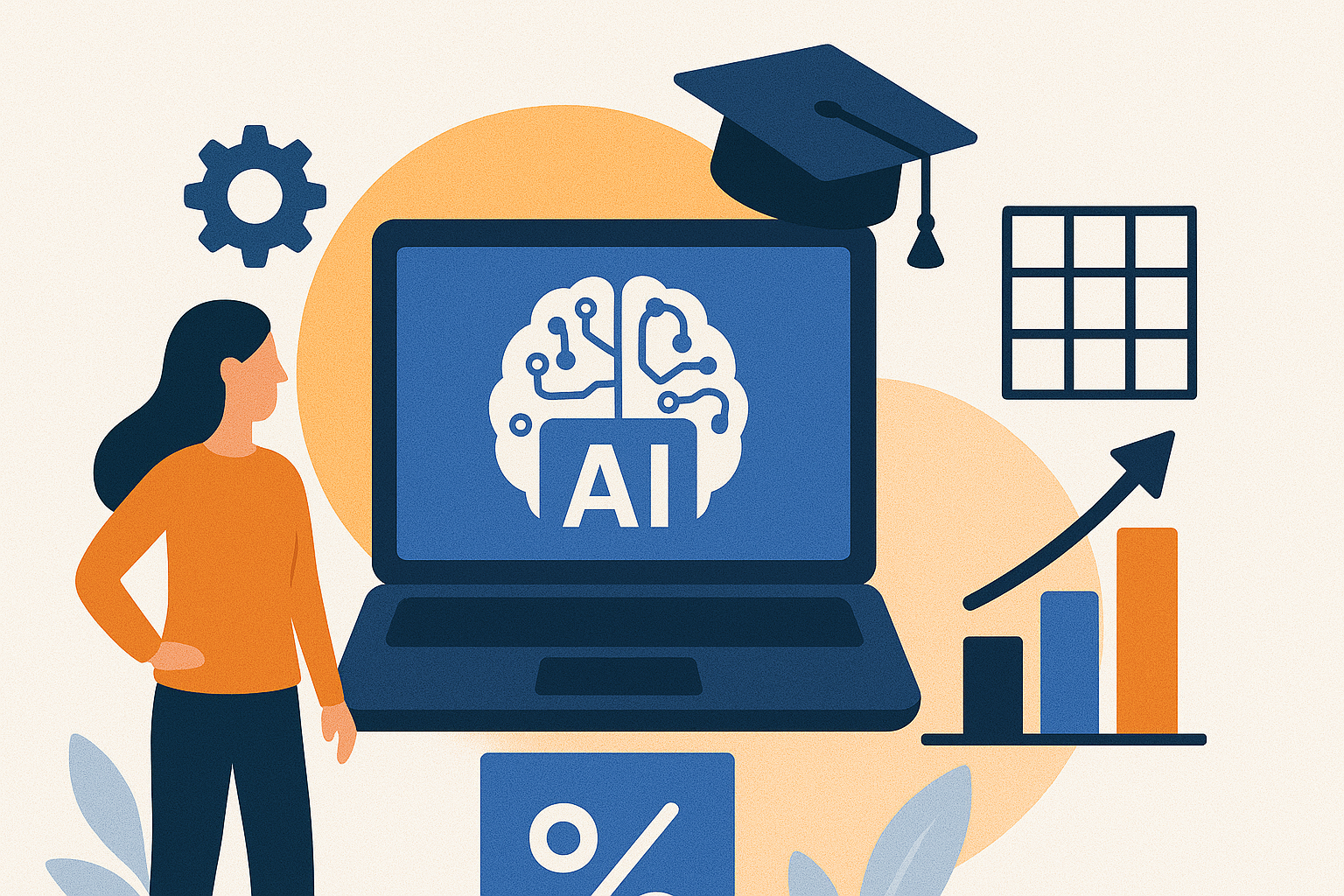About the Blog
Key Takeaways
- Digital workforce transformation empowers businesses to improve efficiency, drive innovation, and adapt to changing market conditions.
- Technologies like AI, automation, and cloud computing are key enablers, while evolving employee expectations demand more flexible, meaningful work.
- A successful transformation starts with digital maturity assessments, strategic upskilling, and the implementation of collaboration tools.
- Companies must overcome barriers like resistance to change, skills gaps, and legacy systems to realize long-term impact.
Introduction
Digital workforce transformation is no longer a futuristic concept—it’s an urgent priority. As higher ed faces accelerating change, competitive pressures, and evolving employee needs, transforming how work gets done has become essential. At its core, digital workforce transformation refers to the integration of digital technologies into every aspect of workforce operations, redefining how people collaborate, learn, and contribute to business success. It’s not just about adopting new tools; it’s about rethinking the people, processes, and platforms that power the modern enterprise.
Organizations that prioritize workforce transformation are not only boosting productivity—they’re building agile, innovation-ready cultures prepared to thrive in uncertainty.
Why Digital Workforce Transformation Matters
Digital workforce transformation creates value for both businesses and their employees. For companies, it leads to improved efficiency through automation and streamlined workflows, fosters innovation by unlocking new ways of working, and increases adaptability by enabling teams to respond quickly to market shifts.
For employees, this transformation means greater flexibility, access to advanced tools, and opportunities for continuous learning. It allows workers to focus on more strategic, fulfilling tasks by automating repetitive work and provides them with platforms that support hybrid collaboration, real-time feedback, and transparent goal-setting.
In short, it’s a win-win: businesses gain a more resilient and future-ready workforce, while employees enjoy more empowered and dynamic work environments.
Key Drivers of Workforce Transformation
Several powerful forces are reshaping today’s workforce. From emerging technologies to shifting expectations and global talent access, these trends are propelling organizations to rethink how they operate and who does the work.
Emerging Technologies (AI, Automation, Cloud)
Technology is the backbone of AI workforce transformation. AI and automation are optimizing workflows by eliminating manual, repetitive tasks and enabling real-time decision-making. For instance, AI can analyze large datasets quickly to surface insights, helping teams work smarter, not harder. Meanwhile, automation handles tasks like onboarding, scheduling, and reporting, freeing up time for strategic work.
Cloud computing has also become essential, offering scalable infrastructure and enabling seamless access to information and collaboration tools from anywhere. This shift to cloud-based systems supports flexibility and business continuity while reducing dependency on outdated, siloed software.
Changing Employee Expectations
Today’s workforce expects more than just a paycheck. Employees now seek flexibility in how and where they work, as well as purpose-driven roles that align with their values. They want to use modern, intuitive tools—not clunky legacy systems. Digital natives in particular expect seamless tech experiences similar to what they use outside of work.
To remain competitive, organizations must redesign employee experiences with these expectations in mind, embracing flexible schedules, clear career pathways, and platforms that support continuous learning and performance transparency.
Globalization and Remote/Hybrid Work Trends
Work is no longer tied to a single location. The rise of remote and hybrid work has given organizations access to a broader, global talent pool. But it’s also created new challenges—how do you maintain collaboration, productivity, and culture when teams are spread across time zones?
Digital workforce transformation enables businesses to navigate these dynamics by adopting cloud-based platforms, asynchronous communication tools, and performance systems that support hybrid environments. It also requires rethinking workforce models—moving from a location-based to an outcomes-based approach.
Steps to Begin Your Digital Workforce Transformation
Embarking on digital workforce transformation requires a clear strategy and strong foundation. It’s not just about adopting the newest tools—it’s about aligning people, technology, and business goals. Below is a roadmap to help organizations get started.
Assess Current Digital Maturity
Begin with an honest assessment of where your organization stands. Evaluate your current digital tools, employee skills, workflows, and cultural readiness. Frameworks like the Digital Maturity Model (DMM) or digital capability audits can help benchmark progress and identify gaps.
This step lays the groundwork for setting realistic goals and choosing the right technologies and initiatives to prioritize.
Identify Roles Most Impacted
Some roles are more likely to be affected by automation and digitization than others. Use data and cross-functional input to map roles that will evolve or become obsolete. Equally important is identifying leadership roles that must champion this change.
Engage your HR and operations teams to develop transition plans, and ensure employees in impacted roles are supported through reskilling or redeployment strategies.
Invest in Training and Upskilling
A digital workforce is only as strong as the skills that power it. Ongoing training is critical to ensure employees can adapt and succeed in a transformed environment. This includes not only technical training on new tools but also soft skills like adaptability, collaboration, and digital communication.
Make sure learning initiatives align with business goals. Consider creating personalized learning paths, microlearning modules, or certification programs tied to strategic priorities.
Implement Collaboration Tools and Platforms
Choose technology platforms that enable your new ways of working. Collaboration tools like Slack, Microsoft Teams, Asana, or Notion can help streamline communication, project management, and knowledge sharing.
Look for platforms that are scalable, user-friendly, and capable of integrating with your existing systems. The goal is to create a digital workspace that fosters real-time collaboration while supporting hybrid and remote workflows.
Measure Progress
You can’t improve what you don’t measure. Track your transformation using clear, meaningful metrics. Common KPIs include employee productivity, tool adoption rates, engagement scores, and time savings.
Regularly gather feedback from employees and adjust your strategy as needed. Digital workforce transformation is iterative—it should evolve as your business and workforce evolve.
Challenges and Barriers to Transformation
Despite its benefits, workforce transformation isn’t without challenges. Awareness of these barriers helps organizations plan more strategically and avoid common pitfalls.
Resistance to Change
Change can be unsettling. Employees may fear job loss, feel overwhelmed by new tools, or distrust leadership’s motives. Clear communication and strong leadership are essential to easing these concerns.
Engage employees early, share the “why” behind changes, and create feedback loops to surface concerns and build trust.
Skills Gap
The gap between current skills and those needed for future roles is growing. Businesses must proactively identify these gaps and offer targeted training before they become a liability. Partnering with educational institutions, creating internal learning academies, or leveraging online platforms can help close this divide.
Integration of Legacy Systems
Legacy systems can slow down or even derail transformation efforts. They’re often incompatible with new tools, lack scalability, and require heavy maintenance. Organizations should develop a phased strategy for replacing or integrating legacy tech, starting with the systems that create the most friction.
A strategic IT roadmap ensures smoother transitions and better ROI from your digital investments.
Conclusion
Digital workforce transformation is no longer a “nice to have”—it’s a necessity. As technology advances, employee expectations evolve, and work models shift, businesses must adapt or risk being left behind. While the path forward may include challenges like change resistance, skills gaps, or outdated infrastructure, the rewards are well worth the effort: a more agile, innovative, and resilient workforce.
By starting with a clear strategy, investing in people, and choosing the right tools, organizations can turn transformation into long-term success. The future of work is already here—are you ready to lead it? Check out more episodes about the future of the digital workforce.
Frequently Asked Questions
How long does digital workforce transformation typically take?
Timelines vary by organization, but a typical transformation journey takes 12–36 months depending on scope and complexity.
What industries are leading in digital workforce transformation?
Sectors like tech, finance, healthcare, and professional services are at the forefront, often due to rapid innovation cycles and customer demand.










